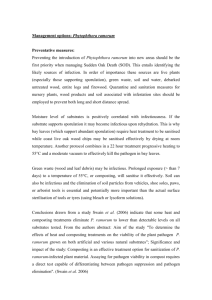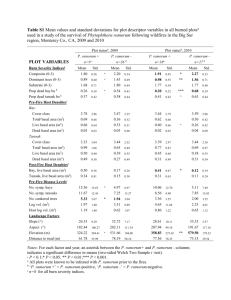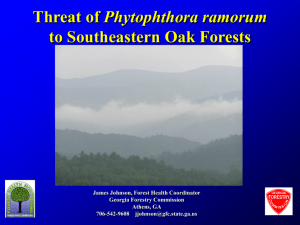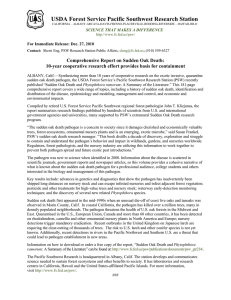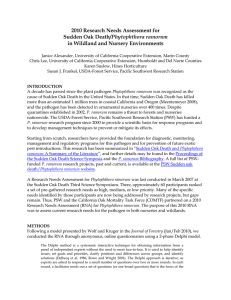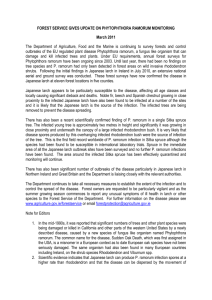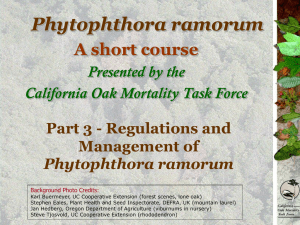S O D
advertisement
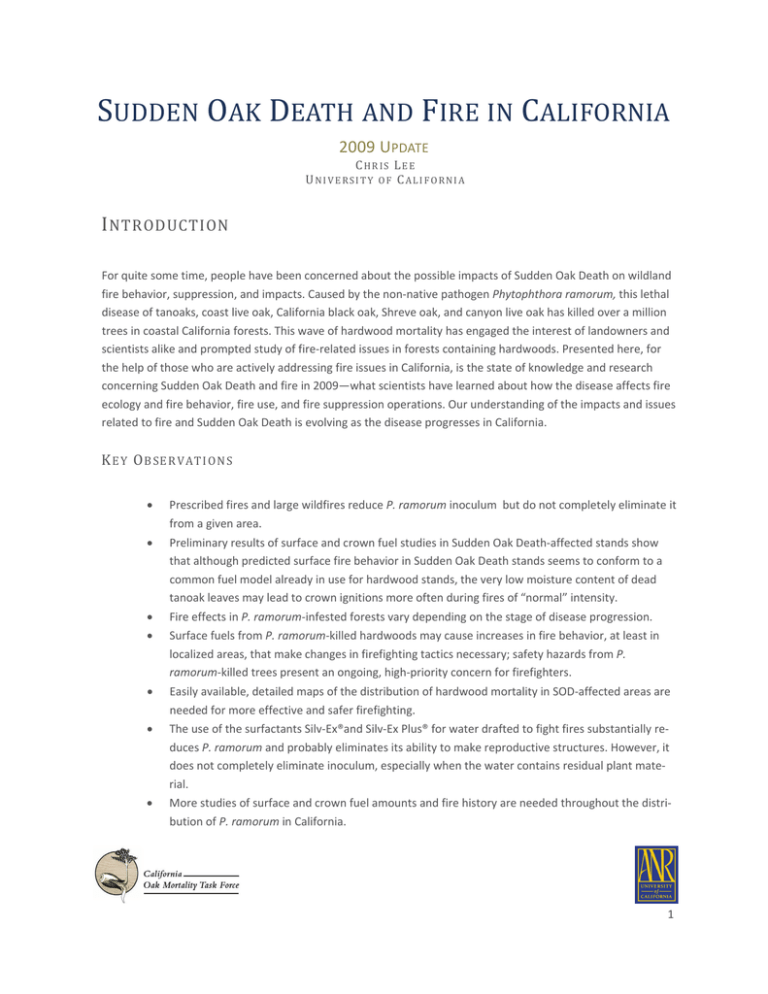
SUDDEN OAK DEATH AND FIRE IN CALIFORNIA 2009 UPDATE C H R I S L E E UNIVERSITY OF CALIFORNIA I NTRODUCTION For quite some time, people have been concerned about the possible impacts of Sudden Oak Death on wildland fire behavior, suppression, and impacts. Caused by the non‐native pathogen Phytophthora ramorum, this lethal disease of tanoaks, coast live oak, California black oak, Shreve oak, and canyon live oak has killed over a million trees in coastal California forests. This wave of hardwood mortality has engaged the interest of landowners and scientists alike and prompted study of fire‐related issues in forests containing hardwoods. Presented here, for the help of those who are actively addressing fire issues in California, is the state of knowledge and research concerning Sudden Oak Death and fire in 2009—what scientists have learned about how the disease affects fire ecology and fire behavior, fire use, and fire suppression operations. Our understanding of the impacts and issues related to fire and Sudden Oak Death is evolving as the disease progresses in California. K E Y O B SE RV A T I O N S • Prescribed fires and large wildfires reduce P. ramorum inoculum but do not completely eliminate it from a given area. • Preliminary results of surface and crown fuel studies in Sudden Oak Death‐affected stands show that although predicted surface fire behavior in Sudden Oak Death stands seems to conform to a common fuel model already in use for hardwood stands, the very low moisture content of dead tanoak leaves may lead to crown ignitions more often during fires of “normal” intensity. • Fire effects in P. ramorum‐infested forests vary depending on the stage of disease progression. • Surface fuels from P. ramorum‐killed hardwoods may cause increases in fire behavior, at least in localized areas, that make changes in firefighting tactics necessary; safety hazards from P. ramorum‐killed trees present an ongoing, high‐priority concern for firefighters. • Easily available, detailed maps of the distribution of hardwood mortality in SOD‐affected areas are needed for more effective and safer firefighting. • The use of the surfactants Silv‐Ex®and Silv‐Ex Plus® for water drafted to fight fires substantially re‐ duces P. ramorum and probably eliminates its ability to make reproductive structures. However, it does not completely eliminate inoculum, especially when the water contains residual plant mate‐ rial. • More studies of surface and crown fuel amounts and fire history are needed throughout the distri‐ bution of P. ramorum in California. 1 F IRE E COLOGY AND B EHAVIOR S U R F A C E F U E L S Moritz et al. (2008) measured surface fuel loading in infested and uninfested stands at Point Reyes National Sea‐ shore and concluded that whereas surface fuel loading was significantly higher in infested redwood/tanoak stands than in uninfested stands, the opposite was true for Douglas‐fir‐dominated stands. Valachovic et al. (2009) measured surface fuel loadings in Douglas‐fir/hardwood forests in Humboldt, Mendocino, and Sonoma Counties, comparing SOD‐infested forests (early and later stages) to forests in which most hardwoods were killed with herbicides to control competition with growing conifers (again, at early and later stages) and to for‐ ests with no P. ramorum presence or herbicide treatment. Preliminary results showed that surface fuel loadings in early‐stage herbicide‐treated plots were similar to those in early‐stage Sudden Oak Death plots, so that one can potentially be viewed as a surrogate condition for the other. They also showed that the Scott and Burgan (2005) fuel model TL2 (Low Load Broadleaf) may be a reasonable match for the surface fuel conditions present in Sudden Oak Death‐affected forests. Finally, when entered into BEHAVE Plus, a burn simulation model, the pre‐ liminary data showed that surface fuel loading conditions present in these forests do not increase flame length, surface rate of spread, or fireline intensity from baseline levels, largely because a substantial canopy is still pre‐ sent to prevent major wind effects at ground level. C RO W N F U E L S Kuljian and Varner (2009) studied foliar moisture characteristics of healthy tanoaks, green tanoaks with symp‐ toms of P. ramorum infection, and dead tanoaks in a confirmed P. ramorum‐infested stand in southern Hum‐ boldt County. They found that foliar moisture content of leaves from dead tanoaks was significantly lower than foliar moisture content of leaves from the other two categories. This was expected, but the magnitude of the difference was entirely unexpected. These foliar moisture content values are so low that they put into question the applicability of the standard crown fire ignition model of Van Wagner (1977) for predicting the likelihood of crown fire ignitions in forests with tanoaks killed by P. ramorum; crown fires may ignite more easily or at a lower crown height than would normally be predicted by the model. Controlled burning experiments are underway in the laboratory to test the conditions of ignition for dead tanoak leaves. FIRE EFFECTS Metz et al. (2009) studied the effects of wildfires in Big Sur in 2008 on SOD‐affected redwood and mixed‐ evergreen forests for which pre‐fire vegetation and disease incidence conditions were known, as part of a net‐ work of existing Sudden Oak Death study plots. They observed greater burn damage to the substrate layer in areas with larger volumes of downed logs; they also observed overall burn severity to increase in plots with re‐ cent mortality, where fine crown fuels such as small twigs and dead leaves were still present. They concluded that fire effects in SOD‐infested forests vary depending on the stage of disease progression and that the great variability in both P. ramorum distribution patterns and fire severity within their study area deserves further attention. FIRE HISTORY Moritz and Odion (2005) examined Geographic Information System (GIS) maps of areas that have burned in Cali‐ fornia within the last fifty years and compared them with maps of areas known to be infested with P. ramorum. In general, they found that the two layers did not coincide: P. ramorum was not generally found in areas that 2 had burned relatively recently. Unfortunately, mapping the distribution of this microscopic, ever‐expanding pathogen is extremely difficult and has not been systematically and comprehensively done. Updating this study with new information about its distribution—and supplementing the GIS study with ground‐based studies of areas burned in the past—is needed. (Left) Surface fuel accumulation in a P. ramorum‐infected stand in Big Sur. Photo: Kerri Frangioso, University of California. (Middle) Creeping underburn in Marin County oak woodland. Photo: Kent Julin, Marin County Fire Department. (Right) Ladder and crown fuels resulting from dead leaf persistence on tanoaks in Big Sur. Photo: Kerri Frangioso, University of California. F IRE U SE E F F E C T S O F S M O K E O N P. R AM ORU M Researchers with the Wildlife Conservation Society, California Department of Food and Agriculture, and UC Berkeley conducted exploratory experiments in which they exposed P. ramorum‐infected plant tissue to varying levels of smoke for varying lengths of time and then attempted to recover P. ramorum from the treated plant tissue. Their observations suggested that (1) smoke exposure only prevented P. ramorum from growing if the pathogen was actively sporulating, and (2) the longer that plant materials were exposed to smoke, the more P. ramorum growth was inhibited (K. Fischer, personal communication; M. Garbelotto, personal communication). In general, smoke conditions in wildland or prescribed fires are rarely as consistent for long periods of time in the forest as in the laboratory, and wildfires do not burn during the wet winter conditions when P. ramorum is actively sporulating. These factors limit the usefulness of smoke as a control option. Smoke from prescribed burn in Marin County. Photo: Kent Julin, Marin County Fire Department. 3 E F F E C T S O F B U R N I N G O N P. R A M O R U M At least three separate efforts have tried to address the utility of broadcast burning in controlling the spread and persistence of P. ramorum. The Marin County Fire Department observed P. ramorum infecting trees in ar‐ eas where prescribed burns had recently happened, suggesting that burning may not eliminate existing infesta‐ tions or prevent subsequent pathogen establishment if the area was previously uninfested. The Department also conducted some prescribed burns on infested properties with both tanoak and coast live oak and noted that infected tanoaks were more susceptible to large amounts of crown scorch than uninfected tanoaks. This observation, which seems to be supported by the observations of Kuljian and Varner (2009), was not true for coast live oaks (K. Julin, personal communication). Near Brookings, Oregon, a Sudden Oak Death eradication team cut the vegetation on several sites and then broadcast burned the sites in an attempt to eradicate P. ramorum. The next year, a small percentage of new tanoak sprouts growing from stumps on these sites were infected. The mechanism of re‐infection (or persistent infection) is not understood (Goheen et al. 2004; Kanaskie et al. 2006; Hansen et al. 2008). In southern Humboldt County, California, a fifty‐acre infested site was treated by removal of all tanoak and bay laurel trees. Half the site was subsequently underburned. Repeated monitoring of the site has recovered P. ramorum from spore traps and soil only very infrequently, and almost always in association with heavy densi‐ ties of bay laurel sprout clumps or where residual bay and tanoak trees were missed during treatment (Valachovic et al. 2009; Valachovic et al. 2008); however, because of dry winter and spring conditions since treatment, the study sites have not yet been subjected to heavy disease pressure. Together with the Oregon results, this suggests that burning can be a valuable tool in cleaning up small infectious material in infested sites but that the pathogen may persist at low levels. Beh et al. (2009) recovered P. ramorum from streams in Big Sur areas that had experienced severe wildfire (and no other treatment) the previous season. Those developing slow‐the‐spread strategies should keep in mind that a single round of treatments is not sufficient to eliminate the pathogen from a given site. (Left) Pile burning after bay and tanoak removal in Humboldt County. Photo: Jack Marshall, CAL FIRE. (Right) Tanoak sprouts infected with P. ramorum (see black‐ ened areas on twigs). Photo: Chris Lee, University of California. F IRE S UPPRESSION F I R E B E H A V I O R A N D S U P P R E S S I O N T A C T I C S Lee et al. (2009) surveyed firefighters, incident team commanders and personnel, land managers, and fire ecolo‐ gists about their observations of fire behavior and fire suppression on the 2008 Basin Complex fires in Big Sur, 4 part of which burned in areas with many large areas of P. ramorum‐caused mortality. Observers reported that flame lengths increased greatly when a moving fire front reached an area of heavy hardwood mortality and that in general, overall fire behavior increased 20‐25% in areas of heavy hardwood mortality. This has implications for fire suppression tactics in such areas, increasing the likelihood that indirect attack tactics such as retreat and backburning will be used. Although no crown fire activity was observed on these fires, spotting increased, both in distance and in quantity. This makes fireline placement and defense more difficult. S A F E T Y I N F O R M A T I O N A N D O T H E R O U T RE A C H N E E D S Lee et al. (2009) also reported that in terms of fire suppression operations, interviewees emphasized that the hazard of falling snags was the most important issue related to P. ramorum‐caused mortality and that more out‐ reach to firefighters related to this hazard needs to be done. In general, communication of Sudden Oak Death‐ related information needs to be increased between various fire management jurisdictions. Higher‐resolution, more comprehensive maps of mortality are a particular need. Producing maps of both statewide hardwood mor‐ tality and infested watercourses (to assist in water drafting decisions) to post on the CAL FIRE Forest Resource and Assessment Program (FRAP) web site was identified as a priority action item. W A T E R D RA FT IN G F O R F I R E S U P P R E S S I O N The UC Davis Rizzo Lab (Aram 2009) tested two surfactant products, Silv‐Ex® and Silv‐Ex Plus ®, commonly added to drafted water to increase wetting of fuels in wildland fire suppression, to see if these products would eliminate propagules of P. ramorum in water drafted from infested streams for application in non‐infested ar‐ eas. They did not recover P. ramorum from aqueous solutions containing these surfactants when they tried to grow the pathogen directly from the solutions. However, when they baited the solutions with rhododendron leaves (a preferred food source for P. ramorum), they did recover the pathogen from a small proportion of the baits placed in the Silv‐Ex Plus® solution as a substrate for the pathogen to colonize. They did not recover it from leaves used to bait the Silv‐Ex® solution; furthermore, the pathogen was only recovered from baits in one trial replication out of eight performed. When the solutions were baited again a week later, no P. ramorum was detected in solutions containing either Silv‐Ex® or SIlv‐Ex Plus®. Based on these results, the testers concluded that SIlv‐Ex® and Silv‐Ex Plus® substantially reduce P. ramorum inoculum in treated water and probably elimi‐ nate its potential for producing further reproductive structures. However, they do not eliminate the pathogen entirely, especially in the presence of host plant material in the water. (Left) 2008 Basin Complex (Big Sur) burning at night. Photo: Kerri Frangioso, University of California. (Middle) Douglas‐fir tree torching in a Marin County prescribed burn. Photo: Kent Julin, Marin County Fire Department. (Right) Fire behavior analyst checking the fire weather. Photo: Kent Julin, Marin County Fire Department. 5 C ONCLUSIONS AND F UTURE R ESEARCH N EEDS Clearly, the role of fire in relation to Sudden Oak Death, and vice versa, is complex. Because of limitations with available source data—both maps of P. ramorum‐caused mortality and maps of historic fire perimeters are generally unreliable—it is difficult to study whether fire changes site characteristics in some essential way that discourages pathogen invasion and persistence. Larger‐scale, ground‐based observation and sampling through‐ out the pathogen’s current distribution will be necessary to further clarify the question. Attempts to control the spread and persistence of P. ramorum using fire and smoke have been only partly suc‐ cessful at best, with the pathogen being recovered at least at minor levels from stream water and soil in areas that have experienced prescribed fires and large wildfires. It may be that for forests in the early stages of dis‐ ease progression, the pathogen will persist at lower levels after fire than in heavily infested forests. This seems to be the case for underburned areas in Oregon and to some degree in Humboldt County. Continued monitor‐ ing of heavily infested forests that were burned in Big Sur in 2008 will provide more information about the lev‐ els of pathogen persistence there. In‐progress studies of surface and crown fuel characteristics in Sudden Oak Death‐affected stands are coming closer to explaining how this disease affects normal cycles of woody decomposition and decay in Douglas‐fir/ hardwood forests of the north coast and how, in turn, it modifies fire regimes there. But since P. ramorum also occurs in many other forest types, some of which are more fire‐prone than others, and the conclusions reached in studies so far may not apply to other areas. To reach a more comprehensive understanding of the Sudden Oak Death’s effects on fuels profiles in California forests, further measurement projects would be needed throughout the state. A network of such projects in the various forest types affected by the disease could provide opportunities for both pre‐ and post‐burn data on the next large wildfire to break out in areas with mortality caused by P. ramorum. Such data are important to have because fire simulation models such as BEHAVE Plus, FARSITE, and FOFEM do not substitute for observing actual fire behavior or effects. Additionally, the role of dead tanoaks and coast live oaks, and how they interact with fire spread, requires more investiga‐ tion. How, for example, do individual standing dead trees contribute to ember production, ember reception, spotting, and fire residence time on the landscape? Hopefully, future work will provide answers to these impor‐ tant questions. 6 Tanoak mortality in southern Humboldt County. Photo: Yana Valachovic, University of California. REFERENCES Aram, K. 2009. An experiment to test the potential of Silv‐Ex® and Silv‐Ex Plus® to eradicate Phytophthora ramorum spores in water. Report available at <http://www.suddenoakdeath.org/html/ current_newsletter.html>. Beh, M., K. Frangioso, K. Aram, and D. Rizzo. The impacts of wildfire on Phytophthora ramorum survival in the Big Sur region. Poster presented at Sudden Oak Death Fourth Science Symposium, Santa Cruz, CA, June 15‐ 19, 2009. Goheen, E., E. Hansen, A. Kanaskie, M. McWilliams, N. Osterbauer, W. Sutton, and L. Rehms. 2004. An eradica‐ tion strategy for Phytophthora ramorum in Oregon coastal forests. Phytopathology 94: S35.: Hansen, E.M., A. Kanaskie, S. Prospero, M. McWilliams, E.M. Goheen, N. Osterbauer, P. Reeser, and W. Sutton. 2008. Epidemiology of Phytophthora ramorum in Oregon tanoak forests. Canadian Journal of Forest Research 38:11,33‐1143. Kanaskie, A., N. Osterbauer, M. McWilliams, E. Goheen, E. Hansen, and W. Sutton. 2005. Eradication of Phy‐ tophthora ramorum from Oregon tanoak forests ‐ status after three years. Paper presented at Sudden Oak Death Science Symposium II, Monterey, CA, January 2005. Kuljian, H. and J.M. Varner. 2009. Effects of sudden oak death on the crown fire ignition potential of tanoak (Lithocarpus densiflorus). Paper presented at Sudden Oak Death Fourth Science Symposium, Santa Cruz, CA, June 15‐19, 2009. Lee, C., Y. Valachovic, S. Frankel, and K. Palmieri. Sudden oak death mortality and fire: lessons from the Basin Complex. Paper presented at Sudden Oak Death Fourth Science Symposium, Santa Cruz, CA June 15‐19, 2009. Metz, M., K. Frangioso, R. Meentemeyer, and D. Rizzo. 2009. Interacting disturbances: did sudden oak death mortality in Big Sur worsen the impacts of the 2008 Basin Complex wildfire? Paper presented at Sudden Oak Death Fourth Science Symposium, Santa Cruz, CA, June 15‐19, 2009. Moritz, M., T. Moody, B. Ramage, and A. Forrestel. 2008. Spatial distribution and impacts of Phytophthora ramorum and sudden oak death in Point Reyes National Seashore. Berkeley, CA. Moritz, M. A. and D. C. Odion. 2005. Examining the strength and possible causes of the relationship between fire history and Sudden Oak Death. Oecologia 144:106‐114. Scott, J. H. and R. E. Burgan. 2005. Standard fire behavior fuel models: a comprehensive set for use with Rothermel's surface fire spread model. USDA Forest Service Rocky Mountain Research Station, Ogden, UT. Valachovic, Y., C. Lee, R. Glebocki, H. Scanlon, J.M. Varner, and D. Rizzo. 2009. Understanding the long‐term fire hazards in forests affected by sudden oak death. Paper presented at Sudden Oak Death Fourth Science Sym‐ posium, Santa Cruz, CA, June 15‐19, 2009. Valachovic, Y., C. Lee, J. Marshall, H. Scanlon. 2008. Wildland management of Phytophthora ramorum in north coast forests. Proceedings of the Sudden Oak Death Third Science Symposium. USDA Forest Service Pacific Southwest Research Station, PSW‐GTR‐214, 305‐313. Van Wagner, C.E. 1977. Conditions for the start and spread of crown fire. Canadian Journal of Forest Research 7:23‐24. 7

